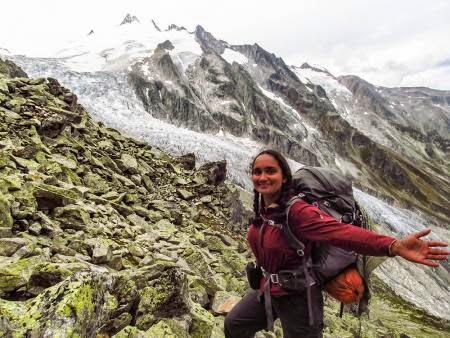
This past summer, not long after collecting her degree from Caltech and thanks to the support of a Watson Fellowship, Hima Hassenruck-Gudipati (BS ’14) found herself walking alone along a creek near the northern Italian town of Feltre, about 50 miles north of Venice. She was not vacationing, but instead was on the hunt for the site of a particular type of rock that offers clues about the most rapid and dramatic climate change in Earth’s history.
Normally, Hassenruck-Gudipati would have tracked her quarry using its GPS coordinates. But on this day, confident that she would find the site easily, Hassenruck-Gudipati only had a map and a field guide with pictures of the rocks. It was not the wisest of decisions, she realized after discovering that the area had no trails. Although unsure of which direction to go, she continued upstream and hiked for hours, searching. Surprisingly, instead of exasperation, she felt exhilaration. “I felt like an explorer,” she recalls.
Eventually, Hassenruck-Gudipati found the site, an outcrop that formed the tall channel bank of the river along which she walked. The outcrop tells the story of the Paleocene-Eocene Thermal Maximum, or PETM, an ancient climate event that occurred some 55 million years ago. During the PETM, the planet’s temperature suddenly spiked as much as nine degrees Celsius over just a few thousand years—a blip of time on the geologic scale. The PETM is one of the best known examples of past climate change, on a par with the Permian-Triassic mass extinction 250 million years ago, when the globe warmed by as much as eight degrees, wiping out about 90 percent of marine species and 70 percent of the animals on land. Studying such dramatic climate shifts in the past can help scientists better understand today’s warming world.
It’s a topic of particular interest to Hassenruck-Gudipati, who majored in mechanical engineering but minored in geology at Caltech. During her time at Caltech, she was keenly interested in green technology and how engineering solutions can mitigate the effects of climate change. But she also developed a fascination with the complex ways Earth responds to a shifting climate. An introduction to the PETM during her junior year left her intrigued; she wanted to learn more, and thought it could be a great topic for a Watson. The fellowship, established by the Thomas J. Watson Foundation in 1968, offers graduating seniors of “unusual promise” a $28,000 stipend to support independent study and travel outside the United States.
One of 44 students awarded the fellowship for the 2014–2015 academic year, Hassenruck-Gudipati is now a few months into a yearlong, worldwide quest to understand the past, present, and future of climate change. She spent the beginning of the summer in Italy and is now in Spain. Her itinerary is constantly in flux. “It’s how the fellowship is set up,” she explains. “They encourage you to shape your itinerary based on what inspires you in the different places and take advantage of new opportunities as they arise.” Currently, she plans to visit Australia in November and then to head to New Zealand, Nepal, Norway, and possibly South Africa.
At each location, Hassenruck-Gudipati has identified geologic sites that will offer insight into the PETM or Earth’s response to a shifting climate. In New Zealand, for example, she will collect fossilized pollen to probe how plants responded to the PETM. In Nepal, she will focus on how climate reshapes mountain landscapes by studying the effect of melting glaciers on erosion. On a Norwegian island called Svalbard, located close to the North Pole, she will study the extremes of both past and present climate change.
Hassenruck-Gudipati often teams up with geologists from local institutions, but for the most part, she is on her own, traveling via bus, bike, or her own two feet, as conditions require. Near the Italian town of Gubbio, a woman camping nearby commended Hassenruck-Gudipati for her bravery, for traveling alone. “It was news to me,” she says. “I never thought of myself as courageous before.”
Note : The above story is based on materials provided by California Institute of Technology










